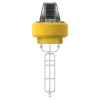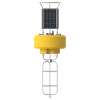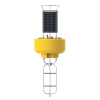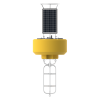NexSens CB-150 Data Buoy
Features
- Integrated 10-watt solar panels for 30-watts of solar charging
- Three 2" diameter sensor holes with female NPT threads for sensor deployment
- Topside plate supports solar marine light, weather stations, and other sensors
- Expedited repair and warranty service
- Lifetime technical support
- More
The NexSens CB-150 Data Buoy is designed for deployment in lakes, rivers, coastal waters, harbors, estuaries and other freshwater or marine environments. The floating platform supports both topside and subsurface environmental monitoring sensors including weather stations, wave sensors, thermistor strings, multi-parameter sondes, Doppler current profilers and other monitoring instruments.
The buoy is constructed of an inner core of cross-linked polyethylene foam with a tough polyurea skin. A topside 13” tall stainless steel tower includes three 10-watt 12VDC semi-flexible solar panels, and a center 10” ID x 13.5” tall data well accommodates batteries, data loggers, sensors, and more. Three 2” passthrough holes with female NPT bottom threads allow for quick connection of instrument deployment pipes and custom sensor mounts. The stainless steel frame supports both single point and multi-point moorings.
The CB-150 Data Buoy is optimized for use with NexSens X3 data loggers. Wireless telemetry options include global 4G LTE cellular, Iridium satellite, and global 4G LTE cellular with Iridium satellite fallback. Compatible digital sensor interfaces include RS-232, RS-485 and SDI-12. Each sensor port offers a UW receptacle connector with double O-ring seal for a reliable waterproof connection. For custom integrations, CB-PTL pass through and CB-MCL wet-mate data well lids are available.
- Hull Outer Diameter: 24.0” (61.0cm)
- Hull Height: 14.0” (35.6cm)
- Data Well Inner Diameter: 10.3” (26.2cm)
- Data Well Height: 13.5" (34.2cm)
- Pass-Through Hole Diameter: 2.0" (5.1cm)
- Tower Height: 13.0” (33.00cm)
- Solar Panels: 3x 10-watts
- Weight: 100 lb (46kg)
- Net Buoyancy: 150 lb (68kg)
- Hull Material: Cross-linked polyethylene foam with polyurea coating & stainless steel deck
- Hardware Material: 316 stainless steel
- Mooring Attachments: 3x 3/4” eyenuts
- (1) CB-150 solar tower
- (1) CB-150 buoy hull
- (1) CAGE instrument cage
In The News
Much Remains Unknown About Sharks. The Cal State Shark Lab Wants to Change That
Thirty years ago, white shark sightings near California’s beaches almost never happened. For Chris Lowe, who was a graduate student at California State University’s Shark Lab at the time, spying a dorsal fin from one of the ocean’s top predators was very rare. Prior to the mid-90’s, an expansive commercial fishing operation and the loss of marine animals decimated white shark populations. If their food wasn’t being hunted, sharks were getting caught in gill nets. At that point, they would be killed anyways before getting brought to the market to be sold. Then in 1994, California residents approved propositions that banned gillnets in state waters and enacted protections for the white shark.
Read MoreLake Superior Weather Buoy Provides Valuable New Data
A new weather buoy in a remote part of Lake Superior is providing much-needed weather data to local mariners, the National Weather Service and researchers. Scientists from the Superior Watershed Partnership (SWP), Lentic Environmental Services (LES) and the University of Colorado-Boulder recently deployed the buoy on the lake one mile north of Stannard Rock Lighthouse. SWP gained ownership of the lighthouse in 2015. Because the light was built on a large reef in a remote part of the lake, it is one of the most popular trout fishing and charter boat destinations on the Great Lakes. It has also been the location of a NOAA weather station since 1984 and a Great Lakes Evaporation Network monitoring site since 2008.
Read MoreNexSens CB-Series data buoys offers lineup from compact to powerful
The 2014 line of CB-Series data buoys combines traditional NexSens Technology reliability with a number of new innovations designed to handle real-time data collection applications in waters from the Great Lakes to the Arctic. Each of the four CB-Series data buoys comes equipped with at least three solar panels, pass-through holes for water sensor deployment and topside mounts for weather sensors. But the buoys’ most exciting enhancement is the addition of a spacious, cross-compatible instrument well that protects your delicate electronics “The biggest change is we now have a large data well that allows us to integrate batteries, data loggers and other electronics,” said Paul Nieberding, Fondriest Environmental general manager.
Read More











































